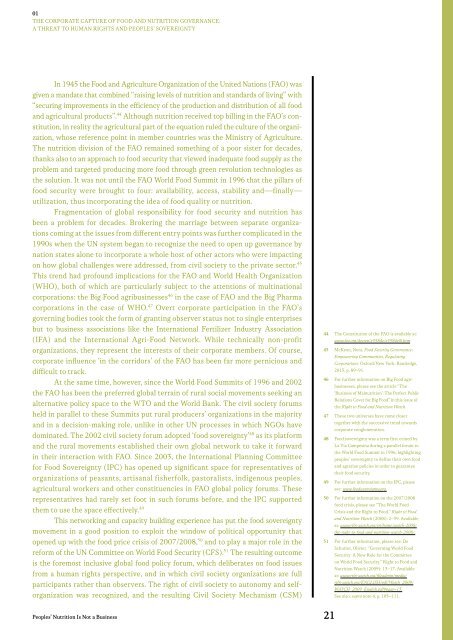RIGHT TO FOOD AND NUTRITION WATCH
1iNBHTY
1iNBHTY
You also want an ePaper? Increase the reach of your titles
YUMPU automatically turns print PDFs into web optimized ePapers that Google loves.
01<br />
THE CORPORATE CAPTURE OF <strong>FOOD</strong> <strong>AND</strong> <strong>NUTRITION</strong> GOVERNANCE:<br />
A THREAT <strong>TO</strong> HUMAN <strong>RIGHT</strong>S <strong>AND</strong> PEOPLES’ SOVEREIGNTY<br />
In 1945 the Food and Agriculture Organization of the United Nations (FAO) was<br />
given a mandate that combined “raising levels of nutrition and standards of living” with<br />
“securing improvements in the efficiency of the production and distribution of all food<br />
and agricultural products”. 44 Although nutrition received top billing in the FAO’s constitution,<br />
in reality the agricultural part of the equation ruled the culture of the organization,<br />
whose reference point in member countries was the Ministry of Agriculture.<br />
The nutrition division of the FAO remained something of a poor sister for decades,<br />
thanks also to an approach to food security that viewed inadequate food supply as the<br />
problem and targeted producing more food through green revolution technologies as<br />
the solution. It was not until the FAO World Food Summit in 1996 that the pillars of<br />
food security were brought to four: availability, access, stability and—finally—<br />
utilization, thus incorporating the idea of food quality or nutrition.<br />
Fragmentation of global responsibility for food security and nutrition has<br />
been a problem for decades. Brokering the marriage between separate organizations<br />
coming at the issues from different entry points was further complicated in the<br />
1990s when the UN system began to recognize the need to open up governance by<br />
nation states alone to incorporate a whole host of other actors who were impacting<br />
on how global challenges were addressed, from civil society to the private sector. 45<br />
This trend had profound implications for the FAO and World Health Organization<br />
(WHO), both of which are particularly subject to the attentions of multinational<br />
corporations: the Big Food agribusinesses 46 in the case of FAO and the Big Pharma<br />
corporations in the case of WHO. 47 Overt corporate participation in the FAO’s<br />
governing bodies took the form of granting observer status not to single enterprises<br />
but to business associations like the International Fertilizer Industry Association<br />
(IFA) and the International Agri-Food Network. While technically non-profit<br />
organizations, they represent the interests of their corporate members. Of course,<br />
corporate influence ‘in the corridors’ of the FAO has been far more pernicious and<br />
difficult to track.<br />
At the same time, however, since the World Food Summits of 1996 and 2002<br />
the FAO has been the preferred global terrain of rural social movements seeking an<br />
alternative policy space to the W<strong>TO</strong> and the World Bank. The civil society forums<br />
held in parallel to these Summits put rural producers’ organizations in the majority<br />
and in a decision-making role, unlike in other UN processes in which NGOs have<br />
dominated. The 2002 civil society forum adopted ‘food sovereignty’ 48 as its platform<br />
and the rural movements established their own global network to take it forward<br />
in their interaction with FAO. Since 2003, the International Planning Committee<br />
for Food Sovereignty (IPC) has opened up significant space for representatives of<br />
organizations of peasants, artisanal fisherfolk, pastoralists, indigenous peoples,<br />
agricultural workers and other constituencies in FAO global policy forums. These<br />
representatives had rarely set foot in such forums before, and the IPC supported<br />
them to use the space effectively. 49<br />
This networking and capacity building experience has put the food sovereignty<br />
movement in a good position to exploit the window of political opportunity that<br />
opened up with the food price crisis of 2007/2008, 50 and to play a major role in the<br />
reform of the UN Committee on World Food Security (CFS). 51 The resulting outcome<br />
is the foremost inclusive global food policy forum, which deliberates on food issues<br />
from a human rights perspective, and in which civil society organizations are full<br />
participants rather than observers. The right of civil society to autonomy and selforganization<br />
was recognized, and the resulting Civil Society Mechanism (CSM)<br />
44 The Constitution of the FAO is available at:<br />
www.fao.org/docrep/x5584e/x5584e0i.htm.<br />
45 McKeon, Nora. Food Security Governance:<br />
Empowering Communities, Regulating<br />
Corporations. Oxford/New York: Routledge,<br />
2015, p. 89–91.<br />
46 For further information on Big Food agribusinesses,<br />
please see the article “The<br />
‘Business of Malnutrition’: The Perfect Public<br />
Relations Cover for Big Food” in this issue of<br />
the Right to Food and Nutrition Watch.<br />
47 These two universes have come closer<br />
together with the successive trend towards<br />
corporate conglomeration.<br />
48 Food sovereignty was a term first coined by<br />
La Vía Campesina during a parallel forum to<br />
the World Food Summit in 1996, highlighting<br />
peoples’ sovereignty to define their own food<br />
and agrarian policies in order to guarantee<br />
their food security.<br />
49 For further information on the IPC, please<br />
see: www.foodsovereignty.org.<br />
50 For further information on the 2007/2008<br />
food crisis, please see “The World Food<br />
Crisis and the Right to Food.” Right to Food<br />
and Nutrition Watch (2008): 2–39. Available<br />
at: www.rtfn-watch.org/en/home/watch-2008/<br />
the-right-to-food-and-nutrition-watch-2008/.<br />
51 For further information, please see: De<br />
Schutter, Olivier. “Governing World Food<br />
Security: A New Role for the Committee<br />
on World Food Security.” Right to Food and<br />
Nutrition Watch (2009): 13–17. Available<br />
at: www.rtfn-watch.org/fileadmin/media/<br />
rtfn-watch.org/ENGLISH/pdf/Watch_2009/<br />
<strong>WATCH</strong>_2009_English.pdf#page=13.<br />
See also: supra note 4, p. 105–111.<br />
Peoples’ Nutrition Is Not a Business 21


